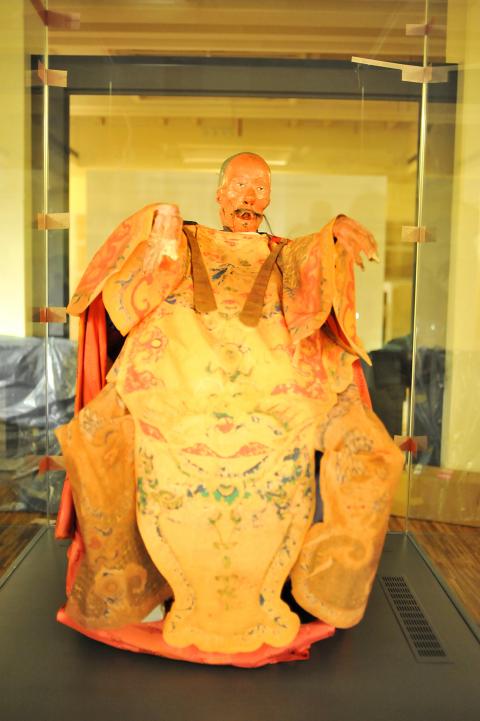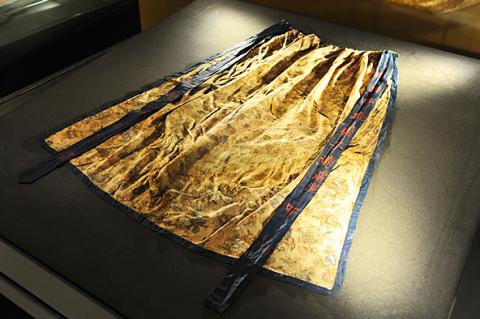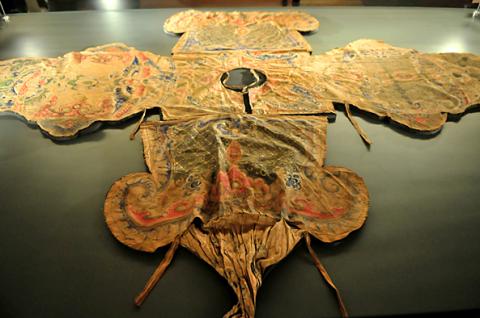For many in our secular society, death means the end. The curators at the National Taiwan Museum, however, believe that the idea of life can take on many forms and, in support of this thesis, has set up a controversial exhibition, Death is Just Another Beginning: Legend of the Taiwanese Mummy Ko Hsiang (死亡只是另一個開始:臺灣木乃伊「柯象」).
Born in 1845, Ko Hsiang (柯象), a shaman from what is today Yunlin County, is probably the only artificially mummified human corpse in Taiwan due to the popular belief at the time that mummification betrays the popular tradition that burying the dead assures their well being (入土為安). In Ko’s case, it is widely believed that he performed the procedure on himself so as to achieve immortality.
CORPSE LOCKED UP

Photo courtesy of National Taiwan Museum
Ko also serves as an important symbol of Taiwan’s anti-Japanese movement, said Li Tzu-ning (李子寧), an associate curator at the museum.
In 1912, almost two decades after Taiwan was ceded to Japan, Huang Chao (黃朝) attempted to rebel against the Japanese authorities in what has become known as the Tuku Incident (土庫事件). Huang planned the uprising in the name of Ko Hsiang, who had become a popular object of worship among religious believers.
“Following the revolt’s failure, police confiscated Ko Hsiang’s [corpse] as criminal evidence. But since no one knew what to do with it, the mummy was kept in police lockup for over 80 years,” Li told the Taipei Times.

Photo courtesy of National Taiwan Museum
Kasaburo Mitsuoka, a judge who paid special attention to the case, wrote in a legal journal that the trial and the use of the mummy as evidence was “an unheard-of bizarre event.”
NOT FOR THE KIDS
In the early 1990s, Ko was put on display at the National Taiwan Museum, stirring up unexpected fear and outrage. The exhibition was forced to close in 1997 due to overwhelming complaints from concerned parents.

Photo courtesy of National Taiwan Museum
“This time, we are not only exhibiting the object itself, we want to tell the story in the backdrop and highlight Ko Hsiang’s significance,” Li said.
In cooperation with National Taiwan Normal University, China Medical University Hospital and Beiji Temple, where Ko resided nearly a century ago, the museum has gathered his wardrobe, forensic records and comments from academics.
“From a scholar’s perspective, I think [the mummy] is extraordinary, mysterious and full of historical resonance. It’s an object that triggers in-depth thinking,” said Fan Yen-chiou (范燕秋), head of National Taiwan Normal University’s Graduate Institute of Taiwan History.
The mummy was a channel through which Taiwanese voiced their discontent with the Japanese government in the early colonial period, she said, interpreting the historic aspect of the sanctified body.
“Everyone sees Ko Hsiang in a different light and we encourage diversity from our audiences,” said Li, pointing to the mummy which has been “very much alive” for 135 years.

The canonical shot of an East Asian city is a night skyline studded with towering apartment and office buildings, bright with neon and plastic signage, a landscape of energy and modernity. Another classic image is the same city seen from above, in which identical apartment towers march across the city, spilling out over nearby geography, like stylized soldiers colonizing new territory in a board game. Densely populated dynamic conurbations of money, technological innovation and convenience, it is hard to see the cities of East Asia as what they truly are: necropolises. Why is this? The East Asian development model, with

Desperate dads meet in car parks to exchange packets; exhausted parents slip it into their kids’ drinks; families wait months for prescriptions buy it “off label.” But is it worth the risk? “The first time I gave him a gummy, I thought, ‘Oh my God, have I killed him?’ He just passed out in front of the TV. That never happens.” Jen remembers giving her son, David, six, melatonin to help him sleep. She got them from a friend, a pediatrician who gave them to her own child. “It was sort of hilarious. She had half a tub of gummies,

The wide-screen spectacle of Formula One gets a gleaming, rip-roaring workout in Joseph Kosinski’s F1, a fine-tuned machine of a movie that, in its most riveting racing scenes, approaches a kind of high-speed splendor. Kosinski, who last endeavored to put moviegoers in the seat of a fighter jet in Top Gun: Maverick, has moved to the open cockpits of Formula One with much the same affection, if not outright need, for speed. A lot of the same team is back. Jerry Bruckheimer produces. Ehren Kruger, a co-writer on Maverick, takes sole credit here. Hans Zimmer, a co-composer previously, supplies the thumping

There is an old British curse, “may you live in interesting times,” passed off as ancient Chinese wisdom to make it sound more exotic and profound. We are living in interesting times. From US President Donald Trump’s decision on American tariffs, to how the recalls will play out, to uncertainty about how events are evolving in China, we can do nothing more than wait with bated breath. At the cusp of potentially momentous change, it is a good time to take stock of the current state of Taiwan’s political parties. As things stand, all three major parties are struggling. For our examination of the